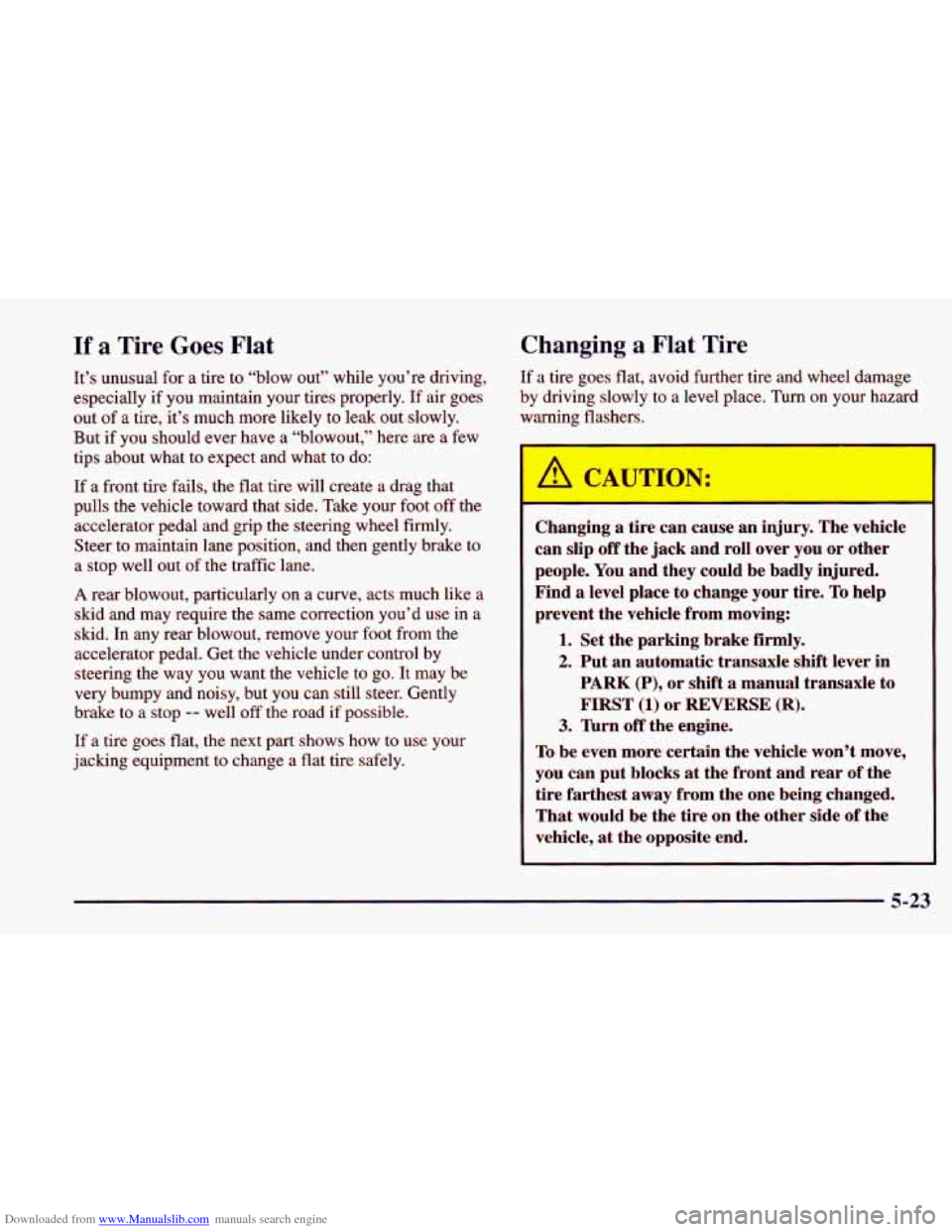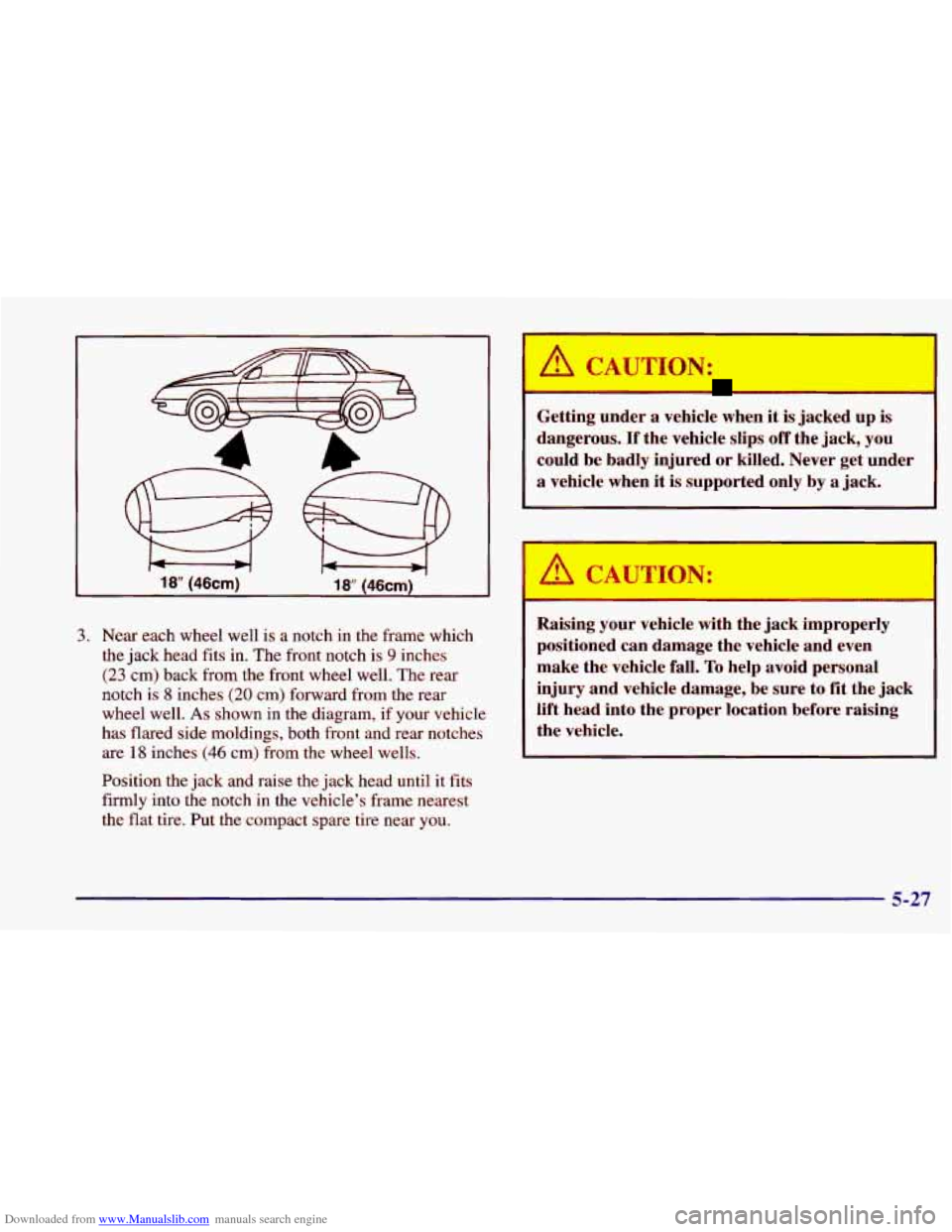Page 245 of 400

Downloaded from www.Manualslib.com manuals search engine If a Tire Goes Flat Changing a Flat Tire
It’s unusual for a tire to “blow out” while you’re driving,
especially if you maintain your tires properly. If air goes
out
of a tire, it’s much more likely to leak out slowly.
But if you should ever have a “blowout,” here are a few
tips about what to expect and what to do:
If a front tire fails, the flat tire will create a drag that
pulls the vehicle toward that side. Take your foot
off the
accelerator pedal and grip the steering wheel firmly. Steer to maintain lane position, and then gently brake to
a stop well out of the traffic lane.
A rear blowout, particularly on a curve, acts much like a
skid and may require the same correction you’d use in a
skid. In any rear blowout, remove your foot from the
accelerator pedal. Get the vehicle under control by
steering the way you want the vehicle to go.
It may be
very bumpy and noisy, but you can still steer. Gently
brake to a stop
-- well off the road if possible.
If a tire goes flat, the next part shows how to use your
jacking equipment to change a flat tire safely.
If a tire goes flat, avoid further tire and wheel damage
by driving slowly to a level place. Turn on your hazard w--+q- ‘?ashers.
I
Changing a tire can cause an injury. The vehicle
can slip
off the jack and roll over you or other
people. You and they could be badly injured.
Find
a level place to change your tire. To help
prevent the vehicle from moving:
1. Set the parking brake firmly.
2. Put an automatic transaxle shift lever in
PARK (P), or shift a manual transaxle to
FIRST (1) or REVERSE (R).
3. nrn off the engine.
To be even more certain the vehicle won’t move,
you can put blocks
at the front and rear of the
tire farthest away from the one being changed.
That would be the tire on the other side
of the
vehicle,
at the opposite end.
5-23
Page 247 of 400
Downloaded from www.Manualslib.com manuals search engine 4 Turn the wing bolt to the
' left and remove it. Then
lift
off the adapter and
remove the spare tire.
I
I
Remove the jack and wheel wrench from the trunk. Your
vehicle's jack and wheel wrench are stored in
a foam
tray. Remove the band around the jack.
1 L
The tools you'll be using include the jack (A) and
wheel wrench
(B).
5-25
Page 248 of 400
Downloaded from www.Manualslib.com manuals search engine Removing the Flat Tire and Installing the
Spare Tire
1. Using the wheel wrench,
remove the plastic nut
,. - -. caps (if equipped).
2. On some models, a cover plate must be removed to
find the wheel nuts. Carefully use the wedge end
of
the wheel wrench to pry it off.
Then use the wheel wrench
to loosen all the wheel
nuts. Don’t remove them yet.
5-26
Page 249 of 400

Downloaded from www.Manualslib.com manuals search engine 18” (46cm) 18‘ (46cm)
3. Near each wheel well is a notch in the frame which
the jack head fits in. The front notch is
9 inches
(23 cm) back from the front wheel well. The rear
notch is
8 inches (20 cm) forward from the rear
wheel well.
As shown in the diagram, if your vehicle
has flared side moldings, both front and rear notches
are 18 inches (46 cm) from the wheel wells.
Position the jack and raise the jack head until it fits
firmly into the notch in the vehicle’s frame nearest
the flat tire. Put the compact spare tire near
you.
A CAUTION:
G&ng under a vehicle wl1m it is JaLried uk 1s
dangerous. If the vehicle slips off the jack, you
could be badly injured or killed. Never get under
a vehicle when it is supported only by a jack.
I
Raising your vehicle with the jack improperly
positioned can damage the vehicle and even
make the vehicle fall.
To help avoid personal
injury and vehicle damage, be sure to
fit the jack
lift head into the proper location before raising
~ the vehicle.
Page 250 of 400
Downloaded from www.Manualslib.com manuals search engine 4. Raise the vehicle by rotating the jack handle to the
right. Raise the vehicle far enough
off the ground so
there is enough room for the spare tire to fit.
5. Remove all of the wheel nuts.
6. If you have a wheel cover, use your fingers to
carefully pull the wheel cover from the wheel. Then
remove the flat tire.
5-28
Page 251 of 400
Downloaded from www.Manualslib.com manuals search engine 7. Remove any rust or dirt
from the wheel bolts,
mounting surfaces and
spare wheel.
Rust or dirt on the wtd, or on thc ," ;o
which it is fastened, can make the wheel nuts
become loose
after a time. The wheel could come
off and cause an accident. When you change a
wheel, remove any rust or dirt from the places
where the wheel attaches
to the vehicle. In an
emergency,
you can use a cloth or a paper towel
to do this; but be sure to use
a scraper or wire
brush later,
if you need to, to get all the rust or
dirt off.
h CAUTION: I
Never use oil or grease on studs or nuts. If you
do, the nuts might come loose, Your wheel could
fall
off, causing a serious accident,
1 wheel-mounting
surface. Replace the
wheel nuts with the
rounded end
of the nuts
toward the wheel.
Tighten each nut
by
hand or with the wheel
wrench until the wheel
is held against the hub.
8. Place the spare on the
5-29
Page 252 of 400
Downloaded from www.Manualslib.com manuals search engine 9. Lower the vehicle by rotating the jack handle to the
left. Lower the jack completely.
10. Tighten the wheel nuts
firmly in a crisscross
sequence, as
shown.
I ' A CAUTION:
Incorrect wheel nuts or improperly tightened
wheel nuts can cause the wheel to become loose
and even come off. This could lead to an accident.
Be sure to use the correct wheel nuts.
If you have
to replace them, be sure to get new
GM original
equipment wheel nuts.
Stop somewhere as soon
as you can and have the
nuts tightened with a torque wrench to
100 lb-ft
(140 Nem).
NOTICE:
Improperly tightened wheel nuts can lead to
brake pulsation and rotor damage.
To avoid
expensive brake repairs, evenly tighten the wheel
nuts in the proper sequence and
to the proper
torque specification.
5-30
Page 253 of 400
Downloaded from www.Manualslib.com manuals search engine Store the wheel cover and wheel nut caps in the trunk
until you have the flat tire repaired or replaced.
I NOTICE:
Wheel covers won’t fit on your compact spare. If
you try to put a wheel cover on your compact
spare, you could damage the cover or the spare.
Storing the Flat Tire and Tools
Storing a jack, a tire or other equipment in the
passenger compartment
of the vehicle could
cause injury. In a sudden stop or collision, loose
equipment could strike someone. Store all these
in the proper place.
m H
A. Wrench
B. Jack
C. Flat Road Tire
D. Adapter
E. Extension
E Wing Bolt
G. Cover
H. Nut (Extension Installed)
Store the flat tire in the compact spare tire compartment
and secure the adapter, extension (aluminum wheel
only) and wing bolt. Store the
jack and wheel wrench in
the foam tray.
5-31